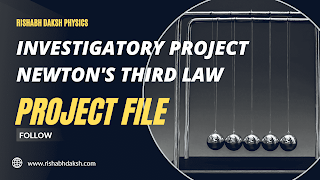Investigatory Project Physics Newton's Third Law of motion Class 11
 |
| Investigatory-project-physics-newtons-third-law-project file |
Creative Project: Newton's Laws of Motion Class 11
Introduction:
Project Overview:
Our project will consist of three interactive demonstrations, each focusing on one of Newton's laws of motion. Along with detailed descriptions, we'll provide the relevant formulas to help you grasp the underlying principles. So, let's get started!1. Newton's First Law: The Law of Inertia
Description:
Newton's first law states that an object at rest will remain at rest, and an object in motion will continue moving with a constant velocity unless acted upon by an external force. This law introduces the concept of inertia, which is an object's resistance to changes in its state of motion.Demonstration:
a) Take an empty glass and place a playing card on top of it.b) Flick the edge of the card with your finger to make it slide off the glass.
c) Now, try the same experiment with a full glass of water and observe the difference in the card's motion.
Explanation:
The first law is demonstrated through the different behavior of the card on the empty glass versus the full glass. The card on the empty glass moves easily due to the lack of external forces, while the water in the full glass provides resistance, making it harder for the card to slide off.Formula:
Newton's First Law: F = 0 (when there is no external force), where F is the net force acting on an object.
2. Newton's Second Law: The Law of Acceleration
Description:
Newton's second law states that the acceleration of an object is directly proportional to the net force acting on it and inversely proportional to its mass. This law links force, mass, and acceleration together.Demonstration:
a) Take a toy car and place it on a flat surface.b) Attach a string to the car and pull it with different forces using a spring scale.
c) Observe how the acceleration of the car changes with varying forces applied.
Explanation:
The second law is illustrated through the car's acceleration. As the force applied to the car increases, its acceleration also increases. The mass of the car influences the acceleration, with a larger mass requiring more force to achieve the same acceleration.Formula:
Newton's Second Law: F = ma, where F is the net force, m is the mass of the object, and a is the acceleration.3. Newton's Third Law: The Law of Action-Reaction
Description:
Newton's third law states that for every action, there is an equal and opposite reaction. This law emphasizes that forces always occur in pairs and act on different objects.Demonstration:
a) Blow up a balloon and hold it closed.b) Release the balloon without tying the end, allowing the air to rush out.
c) Observe the motion of the balloon and the force exerted on your hand.





.png)

No comments:
Post a Comment
Have Any Query ? Ask Here or Comment...